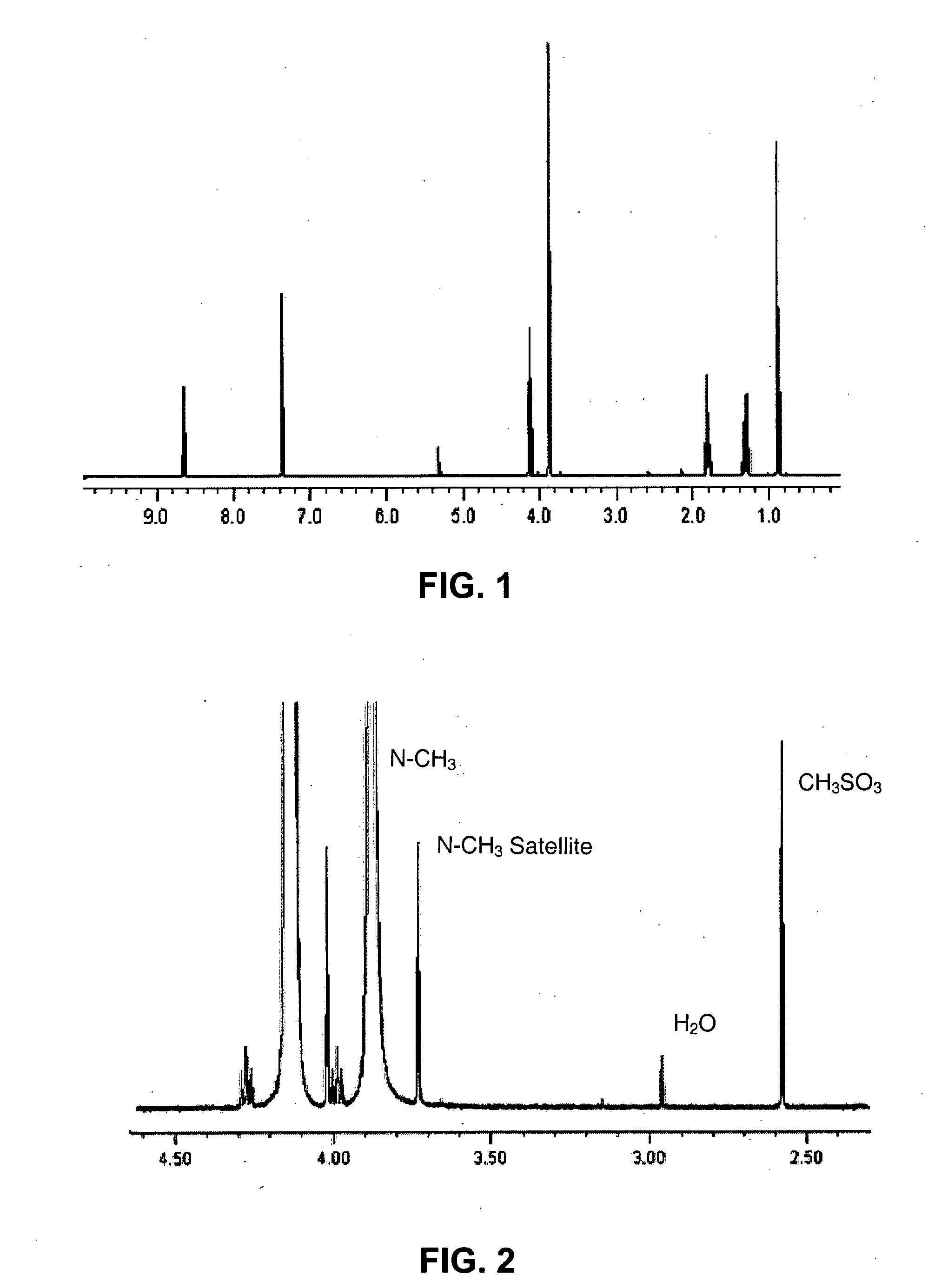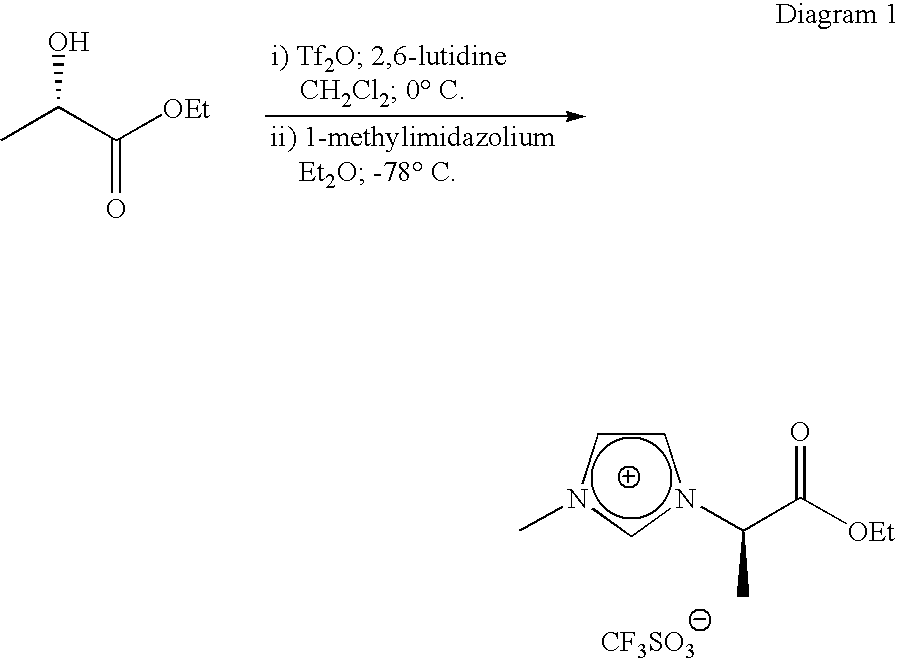Method of preparation of halogen-free ionic liquids and ionic liquids prepared in this manner
a technology of ionic liquids and ionic liquids, which is applied in the field of ionic liquids, can solve the problems of no quick method available, unsatisfactory results, and planned maintenance downtime, and achieve the effect of simple and quick preparation
- Summary
- Abstract
- Description
- Claims
- Application Information
AI Technical Summary
Benefits of technology
Problems solved by technology
Method used
Image
Examples
example 1
1-butyl-3-methyl imidazolium methane-sulfonate (BMI.CH3SO3)
[0048]Butyl methanesulfonate (45.60 g; 300 mmol) was mixed with 1-methyl imidazolium (24.60 g; 300 mmol) and the reaction mixture was allowed to stand at room temperature (25° C.) for 48 hours. After this period of time, an identical volume of acetone and one 1-butyl-3-methylimidazolium methanesulfonate crystal were added, in order to induce the crystallization of the product. The mixture was kept in the refrigerator overnight. A yellow, supernatant solution was decanted from the almost colorless crystals and the crystallization process was again repeated. After drying under vacuum, colorless BMI.CH3SO3 crystals were obtained (59.70 g; 85% yield); the melting point was 77.2° C., RMN—1H (CDCl3) δ:
[0049]9.67 (1H, s, C—H imidazolium);
[0050]7.47 (1H, t, J=1.8 Hz, C—H imidazolium);
[0051]7.36 (1H, t, J=1.8 Hz, C—H imidazolium);
[0052]4.11 (2H, t, J=7.2 Hz, NCH2);
[0053]3.89 (3H, s, NCH3);
[0054]2.59 (3H, s, CH3SO3);
[0055]1.72 (2H, qu...
example 2
1-Butyl-3-methylimidazolium 2-butanesulfonate
[0065]Butyl 2-butanesulfonate (24.88 g; 154 mmol) was mixed with 1-methyl imidazolium (12.30 g; 150 mmol) and the reaction mixture was allowed to stand at room temperature (25° C.) for 60 hours. After this period of time, the yellow reaction mixture became solidified. The crystalline mass was crushed, washed two times with ethyl acetate and dried under vacuum, which produced colorless crystals of 1-butyl-3-methyl imidazolium 2-butanesulfonate (33.10 g, 80% yield), melting point 76.1° C. RMN—1H (CDCl3) δ: 9.80 (1H, s, C—H imidazolium); 7.53 (1H, t, J=1.5 Hz, C—H imidazolium); 7.39 (1H, t, J=1.5 Hz, C—H imidazolium); 4.15 (2H, t, J=7.5 Hz, NCH2); 3.92 (3H, s, NCH3); 2.72-2.60 (1H, m, CH3CH2CH(CH3)SO3); 2.20 5-2.05 (1H, m, CH3CH2CH(CH3)SO3); 1.87 (2H, quintet, J=7.5 Hz, CH2); 1.54-1.30 (3H, m, CH3CH2CH(CH3)SO3 and CH2); 1.32 (3H, d, J=6.8 Hz, CH3CH2CH(CH3)SO3); 0.99 (3H, t, J=7.5 Hz, CH3CH2CH(CH3)SO3); 0.94 (3H, t, J=7.5 Hz, CH3). RMN—13C (C...
example 3
1,3-dimethyl imidazolium methanesulfonate
[0066]Methyl methanesulfonate (5.50 g; 50 mmol) was mixed with 1-methyl imidazolium (4.10 g; 50 mmol) and the reaction mixture was allowed to stand at room temperature (25° C.) for 60 hours. After this period of time, the yellow reaction mixture became solidified. The crystalline mass was crushed, washed two times with ethyl acetate and dried under vacuum, which produced colorless crystals of 1,3-dimethyl imidazolium methanesulfonate (8.16 g, 85% yield), melting point 93.1° C. RMN—1H (CDCl3) δ: 9.81 (1H, s, C—H imidazolium); 7.43 (2H, s, C—H imidazolium); 4.02 (6H, s, NCH3); 2.79 (3H, s, CH3SO3). RMN—13C (CDCl3) δ: 138.5 and 123.3 (C—H imidazolium); 39.4 (CH3SO3); 36.3 (NCH3).
PUM
| Property | Measurement | Unit |
|---|---|---|
| temperature | aaaaa | aaaaa |
| temperature | aaaaa | aaaaa |
| temperature | aaaaa | aaaaa |
Abstract
Description
Claims
Application Information
 Login to View More
Login to View More - R&D
- Intellectual Property
- Life Sciences
- Materials
- Tech Scout
- Unparalleled Data Quality
- Higher Quality Content
- 60% Fewer Hallucinations
Browse by: Latest US Patents, China's latest patents, Technical Efficacy Thesaurus, Application Domain, Technology Topic, Popular Technical Reports.
© 2025 PatSnap. All rights reserved.Legal|Privacy policy|Modern Slavery Act Transparency Statement|Sitemap|About US| Contact US: help@patsnap.com


